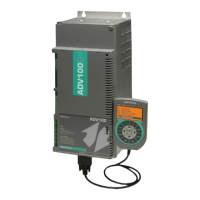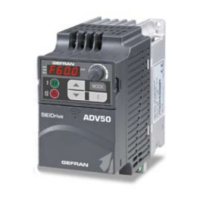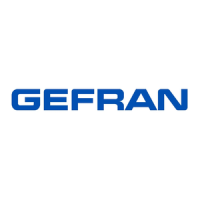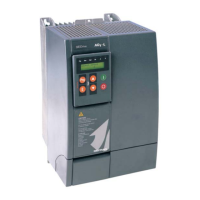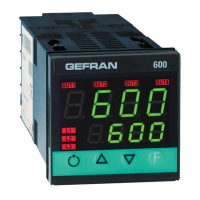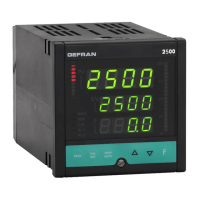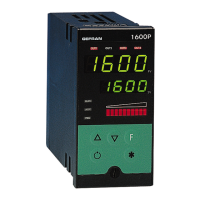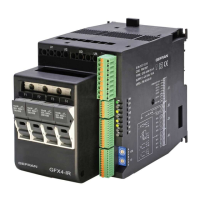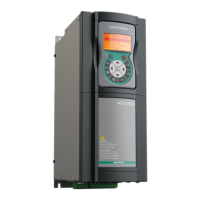24
QS
AVy -HGB
1.9. QUICK TUNING
1. After a complete check of wiring and input
voltage levels and then turn the power on:
·Verify the following voltages must be present:
Terminal 7, +10V to terminal 9 (on regulation
board)
Terminal 8, -10V to terminal 9 (on regulation
board)
Terminal 19, +24…30V to terminal 18 (on
regulation board)
·Check DC link voltage by pressing
[Down
arrow] to get “MONITOR”, then [Enter], then
[Down arrow] to“measurements”, then [Enter],
then
[Down arrow] to “DC link voltage”, then
[Enter].
The value should be:
480-650 vdc for 400 vac input
550-715 vdc for 460 vac input
If it is not within these values, check your line
voltage, as it is unlikely the drive will work
properly.
2. Default to Factory Values: If you are not already
certain of the drive configuration, it is necessary to
default to factory values or copy in a file from a PC
to be certain you are starting from a known
configuration. To default to factory values:
· Default to working memory: Push
[Left
arrow] to get back to “MONITOR”, then [Down
arrow] to “SPEC FUNCTIONS” and then [Enter].
Push
[Down arrow] to “Load Default” and
[Enter]. The factory values will now be loaded
into working memory for all parameters but the
previous values are still in permanent memory.
3. Set Line Voltage:
· Press
[Left arrow] to “SPEC FUNCTIONS”
then
[Up arrow] to “BASIC MENU”, then
[Enter], then [Down arrow] to “Drive type”,
then
[Enter] to “Mains voltage” and [Enter].
Now using the
[Up arrow] / [Down arrow] keys,
change the voltage value closest to your nominal
AC input rating. Then
[Enter] to set the value.
4. Adaption to maximum ambient temperature:
· Press
[Down arrow] to “Ambient temp” then
[Enter]. Now using the [Up arrow] / [Down
arrow] keys, set the maximum ambient
temperature value: 40°C or 50°C, then
[Enter].
5. Load Default Motor Values:
· Press
[Left arrow] until back to “BASIC
MENU” and then
[Down arrow] to “DRIVE
PARAMETER”, then
[Enter], then [Down
arrow] to “Motor Parameter”, [Enter], then
[Down arrow] to “Load Motor Par” and [Enter].
Use the
[Up arrow]/[Down arrow] keys until the
display is the correct motor voltage, then
[Enter].
For 460 VAC motors, select 460, and for 380/400
VAC motors select 400.
6. Set Actual Motor Data:
· Press
[Left arrow] until back to “DRIVE
PARAMETER”, then
[Enter] to get “Mot plate
data” and
[Enter] to “Nominal Voltage” then
[Enter] again to see the value. Using the [Up
arrow]/[Down arrow] keys to change the value
and the
[Left arrow] to move the character
position. When correct press
[Enter].
· Press
[Down arrow] to “Nominal speed”,
[Enter], then use the [Up arrow] / [Down
arrow] keys to get the nominal speed on the
motor nameplate. Press
[Enter] to set data. Note,
some manufacturers of vector motors put the
synchronous speed (exactly 600, 900, 1500,
1800, 3600) for the nominal speed, rather than
the slip speed it would run if run on 50 Hz power.
If this is done, you MUST put a slip speed in this
data. Figure 20 rpm less than the synchronous
speed for these cases.
· Press
[Down arrow] to “Nom frequency” and
[Enter] and set to the nominal frequency on the
nameplate (50 or 60 Hz usually) by using the
[Up arrow] / [Down arrow] keys. Press [Enter]
to set data.
· Press
[Down arrow] to “Nominal current” and
[Enter] and set to the nominal current on the motor
nameplate (rated current) by using the
[Up arrow]
/
[Down arrow] keys. Press [Enter] to set data.
· Press
[Down arrow] to “Cos phi” and [Enter]
and set to the nominal power factor on the
nameplate by using the
[Up arrow] / [Down
arrow] keys (accept the default if you don’t
know). Press
[Enter] to set data.
· Press
[Down arrow] to “Base Voltage” and
[Enter] and set to the base voltage by using the
[Up arrow] / [Down arrow] keys (usually rated
voltage). Press
[Enter] to set data. Look in the
manual for both Base Voltage and Base
Frequency when operating the motor above
normal synchronous speed.
· Press
[Down arrow] to “Base Frequency” and
[Enter], set to the base frequency by using the
[Up arrow] / [Down arrow] keys (usually rated
frequency). Press
[Enter] to set data.
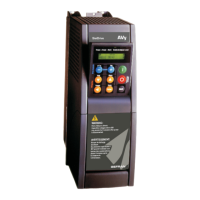
